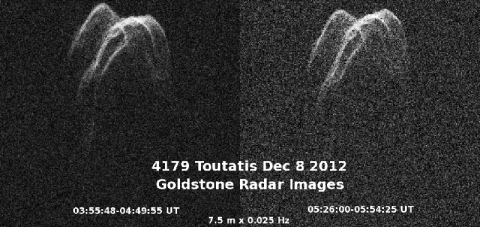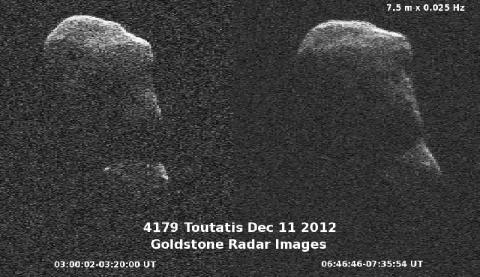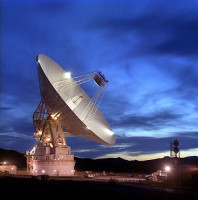Written by Dr. Tony Phillips
Science at NASA
 Washington, D.C. – This week, NASA’s Goldstone radar is tracking a large asteroid as it passes by Earth, and obtaining images of unprecedented clarity.
Washington, D.C. – This week, NASA’s Goldstone radar is tracking a large asteroid as it passes by Earth, and obtaining images of unprecedented clarity.
“At closest approach on December 12th, asteroid 4179 Toutatis will be 7 million km away or 18 times farther than the Moon,” says Lance Benner of NASA’s Near Earth Object Program. “There is no danger of a collision with Earth,” but the asteroid will be close enough for radar imaging.

NASA’s Goldstone radar in the Mojave Desert will be pinging the space rock every day from December 4th through 22nd. The echoes highlight the asteroid’s topography and improve the precision with which researchers know the asteroid’s orbit.
“We already know that Toutatis will not hit Earth for hundreds of years,” says Benner. “These new observations will allow us to predict the asteroid’s trajectory even farther into the future.”

Benner and colleagues are particularly excited about a new digital imaging system at Goldstone that could reveal never-before-seen details on the asteroid’s surface. “Using the new system, we can now image the asteroid’s surface with 2 to 5 times finer resolution than previous flybys,” he says. “We may we see something new on Toutatis.”
It’s probably no coincidence that the tumbling asteroid is elongated and lumpy.
“Toutatis appears to have a complicated internal structure,” says radar team member Michael Busch of the National Radio Astronomy Observatory. “Our radar measurements are consistent with the asteroid’s little lobe being ~15% denser than the big lobe; and they indicate 20% to 30% over-dense cores inside the two lobes.”

This raises the interesting possibility that asteroid Toutatis is actually a mash up of smaller space rocks. “Toutatis could be re-accumulated debris from an asteroid-asteroid collision in the main belt,” he says. The new observations will help test this idea.
Busch points out that the upgraded Goldstone imaging system will produce data with a resolution of 3.75 meters per pixel. “We’ll be putting hundreds of thousands of pixels across the asteroid’s surface.”


